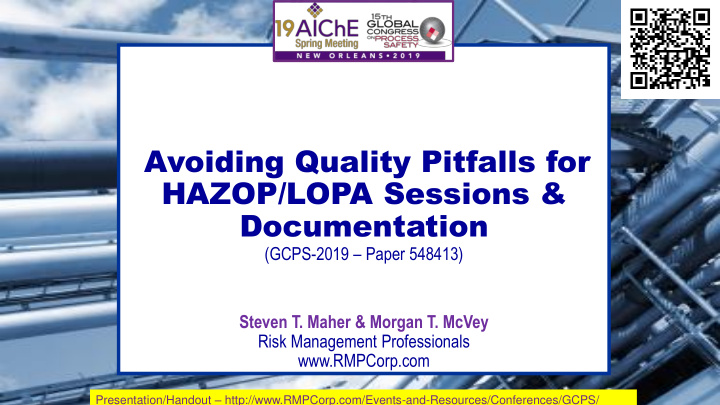



Avoiding Quality Pitfalls for HAZOP/LOPA Sessions & Documentation (GCPS-2019 – Paper 548413) Steven T. Maher & Morgan T. McVey Risk Management Professionals www.RMPCorp.com Presentation/Handout – http://www.RMPCorp.com/Events-and-Resources/Conferences/GCPS/
Steven T. Maher, PE CSP Risk Management Professionals • 39-Year Engineer – 35 in Process Safety Consulting Specializing in Hazard Analysis and QRA • Mechanical Engineering ➢ BS – Duke University ➢ MS – Carnegie-Mellon University • Professional Engineer – Mechanical & Chemical Engineering • CCPS Technical Steering Committee – mid-1980s • Past-President Southern CA Society for Risk Analysis • Landmark Efforts ➢ Platform Safety Shutdown System Effectiveness Study ➢ Torrance Refinery Safety Advisor for MHF Conversion • Paper & Book Publications – See www.RMPCorp.com
Morgan T. McVey Risk Management Professionals • 4 Years in Process Safety Consulting Specializing in Hazard Analysis • Expertise in HAZOP/LOPA Methodologies • Chemical Engineering ➢ BS – University of California San Diego • Paper & Webinar Publications – See www.RMPCorp.com
Avoiding Quality Pitfalls for HAZOP/LOPA Sessions & Documentation (GCPS-2019 – Paper 548413) Steven T. Maher & Morgan T. McVey Risk Management Professionals www.RMPCorp.com Presentation/Handout – http://www.RMPCorp.com/Events-and-Resources/Conferences/GCPS/
Key Topics • Why Quality • Defining PHA Objectives • Planning & Preparation Essentials • Tips for Conducting a Quality PHA • Documentation Tips • Priorities for the Quality Assurance Review • Emphasis Points for Maximizing the Future Usefulness of the PHA • Questions?
Why Quality Process Hazard Analysis is Important Tragedies to Avoid Saratoga News Photo
Evolution of SMS Guidelines & Regulations to Performance (Goal) – Based Standards Onshore Process Safety (USA) Offshore Safety Management Systems (USA) Offshore Safety Management Systems (UK)
Tandem Advances in Protection System Design Architectures & Analysis . Electronic Single-Element Sensing & Voting Logic Analog Devices Sig. Processing Protection System Design Evolution Reliability Criteria & Design Architecture Specifications SIL-1 SIL-2 SIL-3 (10 -2 ≤ PFD AVG < (10 -3 ≤ PFD AVG < (10 -4 ≤ PFD AVG < 10 -1 ) 10 -2 ) 10 -3 ) Safety Integrity Levels
HAZOP & LOPA are Core Elements of Hazard Evaluation Significant Damage due to Fire / Explosion Protection Layers (OP Action, LV-1 or Control Sys, Prot Sys) Bypass Open Null Operator Pressure Bypass Valve Response to Relief LV-1 LT/LIC-1 Inadvertently Alarm Fails Failure Malfunctions Fails High Open by Open Operator Flange Alarm Operator PSV-1 PSV-2 Fails LT/LIC-1 Fails to Leakage Fails to Open Fails to Open to Fails High Respond to Null on Demand on Demand Annunciate Alarm Vessel Failure HAZOP LOPA CHAZOP What-If Checklist FMECA
Planning & Preparation Essentials • Qualified, Experienced, & Prepared: ➢ Technical Experts who Participate in all Phases of the PHA ➢ Facilitator ➢ Scribe Without With Scribe Scribe • Quality-Checked, Complete, & Field-Verified Engineering Drawings • Access to Other Key Process Safety Information • PHA & Revalidation Schedule • Cause Pre-Population Weighing Scribe Options
Tips for Conducting a Quality PHA
Tips for Conducting a Quality PHA • Technical Details ➢ Process Design/Limits & Response to Upset Conditions ➢ Overpressure Ratios ➢ Cause/Consequence Documentation ➢ Instrumentation & Setpoints ➢ Control & Protection System Actions ➢ Valve Failure Mode Clarity ➢ Crediting Alarms as Safeguards ➢ Subcomponent Failure Modes Common Temperature Control System (control station block and bypass valves removed)
Tips for Conducting a Quality PHA • PHA Sessions Company A Scope ➢ PHA Team Training ➢ Session Length Reflecting Process Complexity ➢ Node Completeness Checks ➢ PHA Revalidation vs. Re-do ➢ Node Boundaries ➢ Avoid Repeating Scenarios Company B Scope Node Boundaries to Avoid
Tips for Conducting a Quality PHA • Information Dynamics ➢ Information Requirements & Prioritized Action Items ➢ A “Parking Lot” for Resolvable PHA Issues to Streamline Efforts ➢ Manageable Drawing Updates – Knowing when to Stop ➢ Manageable Information Gaps
Documentation • Analysis Completeness ➢ Specific Causes, with Equipment Numbers Identified ➢ Identify Probable Worst-Case Consequences ➢ Focus on Reliable, Active, Tagged Safeguards with Sufficient Process Safety Time – Link to Cause/Consequence ➢ Recommendations (or gap acceptance) Whenever Clearly-Defined Acceptable Risk Level is Not Achieved ➢ Valid Operating Modes Addressed • Consistency ➢ Risk-Ranking – Consistent & Synchronized with Scenario ➢ Level of Detail & Scenario Depth Pivoting on Importance
Documentation • Usability ➢ Recommendations – Understandable, Self-standing, Logical, Complete • Traceability ➢ Scenarios – Logically-developed, Complete, Understandable ➢ Block Valve Inadvertent Mispositioning ➢ Liberal Use of Clarifying Comments ➢ Risk-Ranking – Consistent & Matched With Scenario ➢ Clear Scope & System Boundaries ➢ Prolific Use of Equipment Tag Numbers & P&ID References
Priorities for QA Review • Completeness Check – All Key Causal Events • Probable Worst-Case Consequences • Safeguard/IPL Verification – Especially Independence • Scenarios – Interpretable • Risk-Ranking – Consistent • Clear Action Items • Same Initiating Event, but Different Deviation – Increased potential for confusion and future misuse
Emphasis Points for Maximizing the Future Usefulness of the PHA Sessions Resources Documentation Maximizing Future Usefulness
Maximizing the Future Usefulness of the PHA • Apply Documentation Traceability Tips • Prolific Use of Equipment Tag Numbers, P&ID References, & Cross-Referencing • Sensible and Consistent Grouping of Scenarios • Use Standardized PHA Approach • Large Nodes Can Allow for a More Holistic Approach • Qualifications and Experience of Facilitator & Team • Consider Long- term Use & Strive for “Evergreen” Approach • Software Longevity & Compatibility 2019 ♦ 2024 ♦ 2029 ♦ 2034 ♦ 2039 ♦ 2044 ♦ 2049 ♦ 2054
Questions? Steven T. Maher, PE CSP Steve.Maher@RMPCorp.com Morgan T. McVey Morgan.McVey@RMPCorp.com 877/532-0806 www.RMPCorp.com Risk Management Professionals
Recommend
More recommend